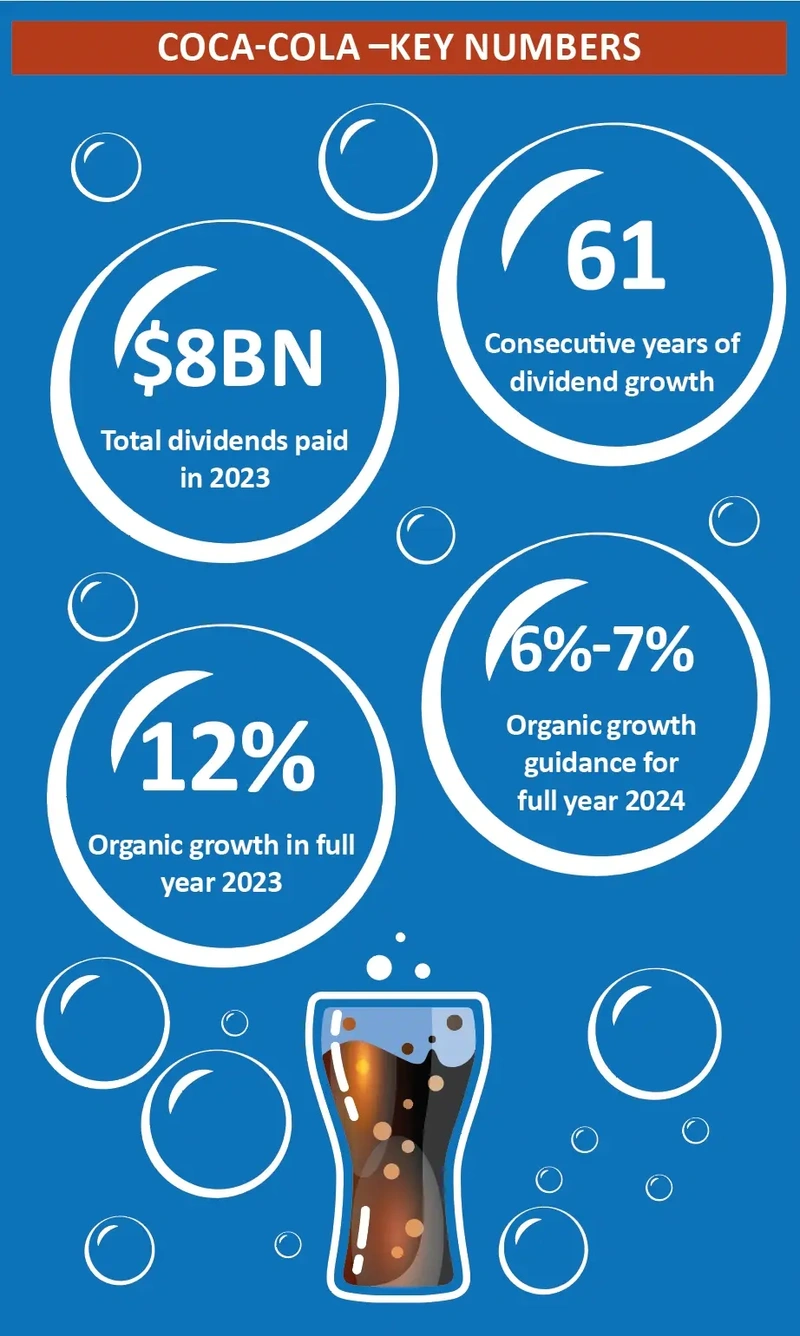Why Coca-Cola is still a sparkling investment

A classic example of a superb business with staying power, The Coca-Cola Company (KO:NYSE) is blessed with iconic brands spearheaded by Coca-Cola or ‘Coke’, the world’s most recognised soft drink synonymous with its red cans.
Coca-Cola’s brands resonate with consumers around the world, making the New York-listed group’s products the beverage of choice for billions when at home or on the move.
Powerful brands, a massive share of the global non-alcoholic drinks market, unparalleled distribution capabilities, cost advantages arising from scale and strong retailer relationships give Coca-Cola what Warren Buffett describes as an economic ‘moat’ or a sustainable competitive advantage which keeps rivals at bay.
The appeal of the Atlanta-headquartered giant’s products means it can charge a premium over lesser-known brands which consumers are willing to pay up for. Combined with low demand elasticity, this affords Coca-Cola considerable pricing power which has enabled the company to grow sales, profits and dividends down the years.
The rising shareholder reward has formed an important part of the total returns for investors through the decades and Coca-Cola’s unbroken dividend growth streak now stretches back 61 years.
Legendary investor Buffett has increased his stake in Coca-Cola over the years and his Berkshire Hathaway (BRK.B:NYSE) conglomerate owns 9.3% of the company, which has proved to be one of the Sage of Omaha’s all-time great investments. In fact, Buffett once quipped that he is ‘a quarter Coca-Cola’ in reference to the amount of his daily caloric intake delivered by the delicious fizzy drink.
HOW DOES COCA-COLA MAKE MONEY?
Eponymous brand Coca-Cola was born at a soda fountain in Atlanta back in 1886 and studies have shown it is among the world’s most-admired and best-known trademarks; it has even been documented that Coca-Cola is the second-most widely understood term in the world after ‘okay’.
Intriguingly, the formula for making Coca-Cola remains the best-kept secret in the world of food and drink, and the brand itself has provided a winning formula for patient portfolio builders down the years including Buffett.
The investment case for the world’s largest non-alcoholic beverage company is much more than the flagship brand, however, since Coca-Cola is a ‘total beverage’ company with products sold in more than 200 countries and territories and a formidable portfolio of 200 brands spanning carbonated soft drinks, water, sports, energy, juice, and coffee.
Its sparkling soft drinks portfolio includes Sprite and Fanta, although the company also owns an array of water, sports, coffee and tea brands, among them the likes of Dasani, smartwater and Topo Chico, BODYARMOR and Powerade, and Costa Coffee and Gold Peak Tea.
It also owns a slew of juice, value-added dairy and plant-based beverage brands ranging from Minute Maid and innocent to Del Valle and fairlife, not forgetting its increasingly valuable 19.6% equity stake in energy drinks developer and marketer Monster Beverage (MNST:NASDAQ).
The business model sees Coca-Cola manufacture and sell concentrates and syrups to its network of bottling partners, while still owning the brands and holding sway over the brand marketing initiatives.
Two of its major bottling partners are London-listed companies, namely Coca-Cola HBC (CCH) and Coca-Cola Europacific Partners (CCEP), the latter being the largest Coca-Cola bottler in the world by revenue and volume. These bottling partners use the concentrates and syrups to make, package and distribute the finished soft drinks to customers, who then sell Coke to consumers.
Under chair and chief executive James Quincey, Coca-Cola has a strategic focus on a ‘total beverage’ portfolio and its pivot to non-sparkling categories bodes well for healthy top-line growth going forward.
North America is Coca-Cola’s biggest market, representing 36% of revenues in the year to December 2023 and 30% of operating income, but the drinks giant generates around two thirds of sales overseas with a significant portion from emerging economies in Latin America and Asia-Pacific.
One revenue segment with big growth potential is Global Ventures, which includes Costa, the $4.9 billion acquisition from Whitbread (WTB) completed in early 2019 which gave Coca-Cola a footprint in the global coffee business. Global Ventures also includes the Monster Beverage stake as well as Innocent juices and smoothies and Dogadan tea.
Under Quincey’s stewardship, Coca-Cola is constantly transforming its portfolio, either by reducing sugar in its drinks or launching innovative new products, and has a major focus on sustainability by replenishing water and promoting recycling.
Despite tracing its origins back to 1886, Coca-Cola regards itself as a growth company providing ‘brands and beverages that make life’s everyday moments more enjoyable’. As Quincey has said, ‘We’re building this business for the next century: not just the next quarter.’
Consumer concerns over the health impact of carbonated, sugary drinks and restrictive regulations have been headwinds which Coca-Cola has navigated, and there are numerous growth opportunities ahead of it in the reformulation of classic recipes, new ‘better-for-you’ products with natural ingredients, not to mention expansion in under-penetrated markets ranging from India and South East Asia to Africa.
While the Coca-Cola drink accounts for the bulk of total sales, newer brands are contributing to higher growth overall. In the fourth quarter, trademark Coca-Cola sales were up 2% year-on-year while revenue from juice, value-added dairy, and plant-based beverages increased by 6% driven by Minute Maid brand Pulpy in China, the Mazoe brand in Africa and the Fairlife dairy brand in the US.
The canny Quincey always has an eye on the future too. For instance, in last year’s fourth quarter, Coca-Cola leveraged the success of its first artificial intelligence-based platform, ‘Create Real Magic’, by inviting consumers to create shareable, digital greeting cards featuring its iconic brand assets such as cherished depictions of Santa Claus and the Coca-Cola polar bear.
HOW IS COCA-COLA PERFORMING?
While the drinks sector faces headwinds from geopolitical uncertainties, the cost-of-living squeeze and raw material inflation, not to mention consumer concerns over the sugar content of fizzy drinks, a backlash over single-use plastic and an emerging threat from anti-obesity drugs, Coca-Cola has continued to serve up refreshingly robust operating numbers.
The company delivered organic revenue growth of 12% for the year to December 2023 based on broad-based 2% volume expansion, which was actually better than the 1% contraction at great rival PepsiCo (PEP:NASDAQ), although Coca-Cola is forecasting an organic growth slowdown to between 6% and 7% this year and needs to ensure it doesn’t push price increases too far, since consumers are still grappling with pressured finances.
‘We attribute the volume resilience to the firm’s consumer-valued innovations in ingredients, formulas, and packaging, as well as smart digital marketing that resonates with consumers globally,’ wrote Morningstar analyst Dan Su back in February.
‘Despite a softening consumer backdrop and intense competition in the beverage aisle, we think the firm remains well-positioned to capture growth in the coming years, thanks to heavy investments in innovations and brands, as well as deft in-market executions that assert its competitive standing globally,’ added Su.
WHAT DO FUND MANAGERS THINK?
Fran Radano is the manager of The North American Income Trust (NAIT), which has a stake in what he describes as the ‘premier global beverage leader’ with a resilient business model. Under Quincey’s total beverage strategy, Radano says, Coca-Cola ‘seeks to create a compelling offering across all daily needs including simple refreshment, sports drinks, health focused beverage and many other need states’.
The company has also ‘invested and collaborated with its strong bottling system which has resulted in driving above trend sales and subsequently improved market share positions despite already leading from a position of strength. Furthermore, the beverage category is an advantaged category from a growth perspective globally and Coca-Cola’s scale benefits and execution expertise positions it well in the future.
‘The result of its capital-light business model is a robust amount of free cash flow which continues to be reinvested in the business, used for opportunistic M&A as well as distributing the majority of the company’s surplus funds to shareholders via a progressive, covered dividend. Share repurchase is typically done on a smaller scale as a means to keep the share count flat to optimise its cost of capital.’
Morningstar scribe Dan Su believes Coca-Cola has built ‘a wide economic moat around its global beverage operations based on strong intangible assets and a significant cost advantage that will enable the company to deliver excess investment returns above its cost of capital over and beyond the next 20 years’.
James Cook, one of the managers of investment trust JPMorgan Global Growth & Income (JGGI), says: ‘While historical analysis and current metrics suggest consumer staples are overvalued on a global basis, we think the US names appear more fairly priced. One name we like is Coca-Cola. The company has immense pricing power, no significant competition and has a wholesale and concentrate business model. Think about it, you’re selling a can of Coke at about 70p. This pricing power makes for rather attractive dividends.’
Important information:
These articles are provided by Shares magazine which is published by AJ Bell Media, a part of AJ Bell. Shares is not written by AJ Bell.
Shares is provided for your general information and use and is not a personal recommendation to invest. It is not intended to be relied upon by you in making or not making any investment decisions. The investments referred to in these articles will not be suitable for all investors. If in doubt please seek appropriate independent financial advice.
Investors acting on the information in these articles do so at their own risk and AJ Bell Media and its staff do not accept liability for losses suffered by investors as a result of their investment decisions.
Issue contents
Danni Hewson
Feature
Great Ideas
News
- Lloyds Bank cuts risk monitoring in effort to drive change
- Lok’n Store shares leap on Shurgard cash offer
- Shares in personal care firm PZ Cussons hit 20-year low
- Has Associated British Foods-owned Primark maintained its momentum?
- Prospects for US interest rate cuts reduced as inflation remains sticky
- Service sector inflation undermines market rally
- Can Amazon continue to beat ‘The Street’?
- What have we learned from the US banks’ first-quarter updates?

 magazine
magazine









